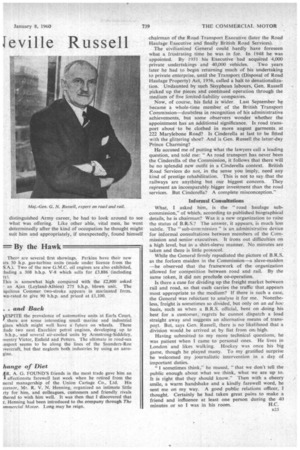Bird's Eye View
Page 50

Page 51

If you've noticed an error in this article please click here to report it so we can fix it.
The Working Man's Institute
By the Hawk
— MR. PATRICK THURSFIELD, one of the joint secretaries of the new Road and Rail Association, remonstrated earnestly but kindly with me, the other day, about the suspicious reception given by The Commercial Motor to that organization. If he did not entirely convince me that there is virtue in politicians, he at least satisfied me of the Association's honourable intentions. Their aim, it seems, is to be the layman's Institute of Transport. They want to make ordinary people conscious of transport and its importance in the national scheme. They hope even to prevent some of the twaddle that is talked about transport in Parliament and elsewhere by vociferous people whose love of their own voices exceeds the range of their knowledge.
The method is to collate authenticated information on all branches of transport, and to present a broad picture on a variety of topics. Opinions will, I am assured, be identified with those who express them, and there will be no attempt to influence the use of one system of transport or another. And the service is free to anyone who seeks it.
25-Year Partners
HULL CORPORATION and East Yorkshire Motor Services, Ltd., have celebrated the Silver Jubilee of their "marriage." Its benefits to the travelling public are explained in a leaflet which has been produced to mark 25 years of co-ordinated bus operation by the municipality and company. The leaflet obliquely suggests that some other municipal and company B24 operators would be well advised to consider a similar scheme. In the case of residents of Hull, it is providing the greatest availability of buses without unnecessary mileage, which would have been an extra burden on fares.
Down to the Sea . . .
THE glitter of Britain's sixth National Boat Show, which closes at Earls Court tomorrow, cannot disguise the large number of commercial-vehicle engines which have been adapted for marine applications. Indeed, it seems that there are few automotive engines that do not go to sea these days. Bedford, B.M.C., Comrner, Foden, Ford, Leyland, Perkins, Rolls-Royce, Standard and Thornycroft units are there in force, while foreign engines include examples from America, Germany and Sweden shown by Chrysler, G.M.C., Mercedes-Benz. Volkswagen and Volvo. Them are several first showings. Perkins have their new ars 50 h.p. gas-turbine units, (made under licence from the S.A.). Two of the new G.M.C. oil engines are also exhibited, aiding a 308 b.h.p. V-8 which sells for £3,886 (including
this is somewhat high compared with the £2,800 asked an Ajax (Leyland-Albion) 275 b.h.p. blown unit. The iquitous Commer -two-stroke appears in marinated form. wn-rated to give 90 b.h.p. and priced at £1,100.
. . and Back
)ESP11E, the prevalence of automotive units at Earls Court, there are some interesting small marine and industrial gines which might well have a future on wheels. These ;lude two neat Excelsior petrol engines, developing up to b.h.p., and several air-cooled units by Armstrong-Siddeley, Iventry Victor, Enfield and Petters. The ultimate in road-sea Lnsport seems to be along the lines of the Saunders-Roe wercraft, but that neglects both industries by using an aerogine,
hange of Diet
vt. A. G. FOUND'S friends in the meat trade gave him an
affectionate farewell last week when he retired from the neral managership of the Union Cartage Co., Ltd. His ccessor, Mr. R. V. N. Henning, organized an intimate little rty for him, and colleagues, customers and friendly rivals thered to wish him well. It was then that I discovered that r. Henning had been introduced to the company through The nnmercial Motor. Long may he reign.
























































































































































